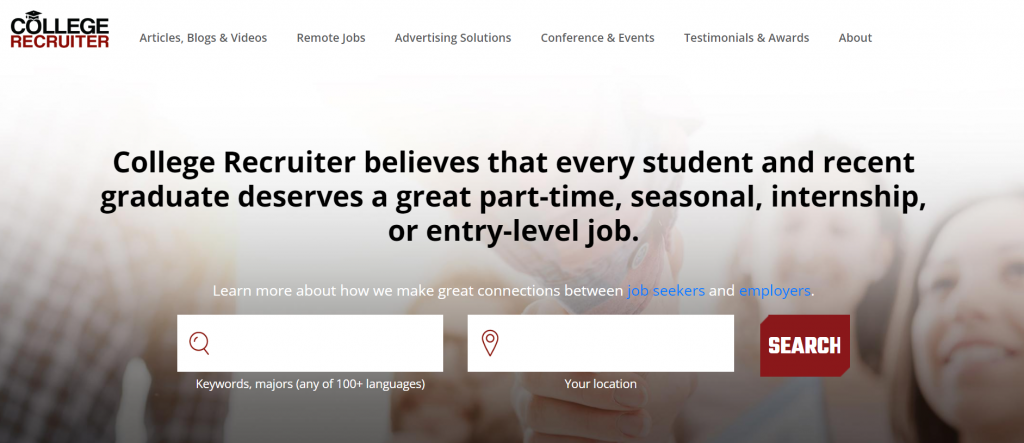
Undergraduate students often experience work on their way through college. There are many reasons, like gaining life experience, developing social and personal connections, or earning extra money. Another important reason that drives students to work while studying is to master skills and get career-related experience before starting to work as graduate specialists.
According to Jooble’s analysis of the customers’ activity at the website https://jooble.org/ for the last three months, the demand for work and proposition from employers remain stable. Most vacancies for students during mid-summer can be found in New York, Washington, Chicago, Boston, Denver, Ohio, Columbus, Kansas City, San Antonio, and Springfield.
Also, according to Jooble’s research, most often in the past three months, students in the United Stated were looking for internships or part-time jobs in architecture, law, and different medical or seasonal summer positions. Most students indicated in their search requests that they were looking for part-time employment only, as they have to accommodate work with their college schedules.
To better understand the nuances of the student’s employment, we talked with Steven Rothberg, Chief Visionary Officer and Founder of the College Recruiter, the leading job search site used by students and recent graduates. Steven has many years of experience in employing students and shared with Jooble his thoughts about it.

One of the things about how students’ employment has changed in recent years is the diversification of the channels for searching student candidates. Until on-campus recruitment essentially shut down in the spring of 2020 due to Covid-19, the vast majority of students and recent graduates were hired through on-campus recruitment by large employers. Today, it is still true that large employers employ most, but what is no longer valid is that the hiring is done almost exclusively through on-campus efforts.

“In 2020 and 2021, these large employers were forced to modernize, and many discovered that they could exponentially accelerate their time-to-hire and reduce their cost-to-hire by using virtual sourcing tools like job boards.”
Also, Steven notes that one of the core things to make a successful hire of the student is that employers should first directly indicate what they expect from the potential employee and update the information to avoid misconceptions.
“Every role within every organization is different, and what an employer may have wanted for a particular role a year ago could be quite different from what they want today.”
In hiring students, employers should also understand that if students are applying for a job, they likely feel they can do it. Many believe they don’t have experience, but usually, they all do have it. Another employer may not have paid them to do the same job, but they had a previous job; even if this job was years ago and part-time, any work experience will help students be productive in this role. Still, there is nothing wrong with the employer also asking about it. Presenting themselves and their experience is the primary task for the student if they are interested in getting a job and not becoming a low-risk hire.
Nevertheless, the absence of experience, a minor or irrelevant experience, is not a green light for the employer to treat students worse and pay them less than any other workers. As Steven says, the employers’ practice of fully staffing their operations despite paying their employees a little and mistreating them has already become a thing of the past. Luckily, the current labor market has shown employers that such an approach doesn’t work, and each student is an individual who can bring something new to the organization and is not just a workforce.
“That means that a student might receive an offer of employment that offers great pay but lousy experience, or vice versa.”
But if we are talking about hiring recent graduates who have already attained their degrees, finding and hiring the candidates will somehow differ.
“The currently enrolled students are more likely interested in attaining great work experience than great pay. The recent graduates in a contrary are most likely already have some great work experience, and will be more interested in the pay and opportunities for advancement”, Steven says.
He also adds that currently enrolled students vastly outnumber their recent graduate counterparts in terms of the usage of their college and university career service offices. There’s a saying that the day you graduate is the day you stop using the services of your career service office.
“If an employer wants to hire a currently enrolled student for an internship, for example, the career service office will be one of the best sources for that employer. But if that same employer wants to hire someone who graduated months or even a year ago, it is very unlikely that the career service office will be of any help as they tend to be ignored by the graduates.”
Also, an interesting point about hiring students is that students can be of different generations. Younger students such as Gen Z (1997-2012 years of birth) are more likely to be open to relocating and applying the skills they’ve acquired to jobs they may not have envisioned accepting, or maybe even jobs they didn’t know existed. Employers should consider this to hire the person who will be the most motivated for a particular work.
“They tend to be more flexible, but that flexibility can also lead them into making poor choices that cause them to become dissatisfied and leave for jobs which are a better fit.”, Steven says.
Employers must not try to persuade one of these candidates to take a job just for filling in a position or getting a non-high paid workforce. It is much better to ensure that the employee will be highly productive for years.
Older students such as members of Gen Y (1981-1996 years of birth) are more likely to have families and be pretty set in terms of where they want to live and the kind of work they want to do. They’re far more likely to be changing careers, and deciding to change a job is rarely taken without much thought. Even before they enrolled, they probably knew what kind of role they wanted and knew that going back to school to continue their education was the best and perhaps the only way of achieving that goal. For employers targeting these candidates, it is best to approach them as you would lateral hires, more like a peer and not someone new to the workforce.
One more critical aspect of the successful students’ hire is the question of benefits they can get from the employer except for payment and experience. Recent surveys of currently enrolled students show that these benefits are:
– the possibility of working at least partially remote;
– offer pay that isn’t just competitive with similar employers in the same industry but prevailing for the talent so across different kinds of employers in all sectors;
– a demonstrated ability and willingness for the employer to be loyal to its workers even in difficult economic times;
offers quality training and opportunities for advancement; and a diverse, equitable, and inclusive workplace.
Remember that no employees at any company get everything from the job they want, and no company gets everything from the employees it wants. There is always a place for compromise in questions related to work. One of such questions is about accommodating the working process with the student’s schedule with no loss in productivity.
“The student employee that most employers think of is becoming less and less common. Many employers think of the full-time student attending a four-year college or university who might only work 10 to 20 hours a week during the school year, if at all, and want a job during the summer for two or three months. There are many who still fit that bill, but more and more students work full-time, year round. Some of them also attend school full-time, but many attend part-time. Employers should not assume that a candidate is only seeking work that is part-time, temporary, or both. All it takes for the employer to determine the desired work schedule of a candidate is to ask. An easy way to do that is a dropdown box during the application process.”